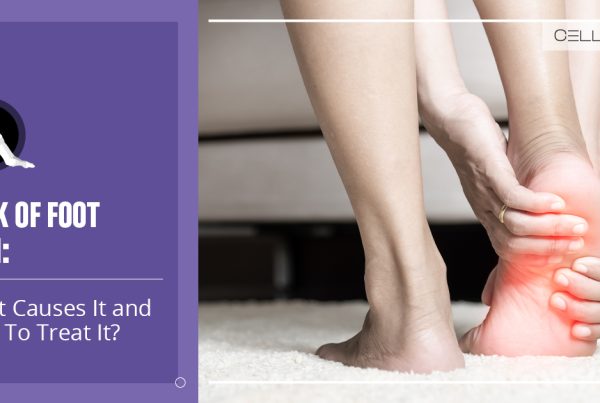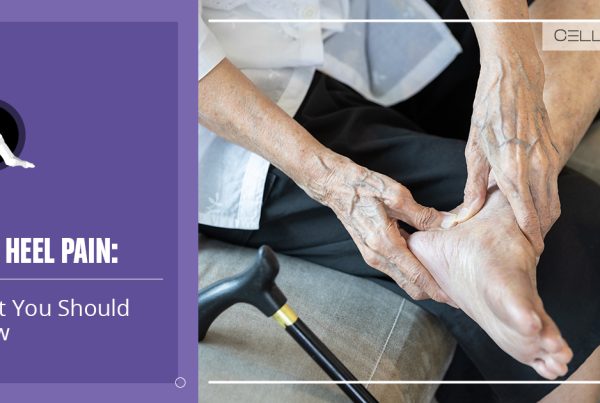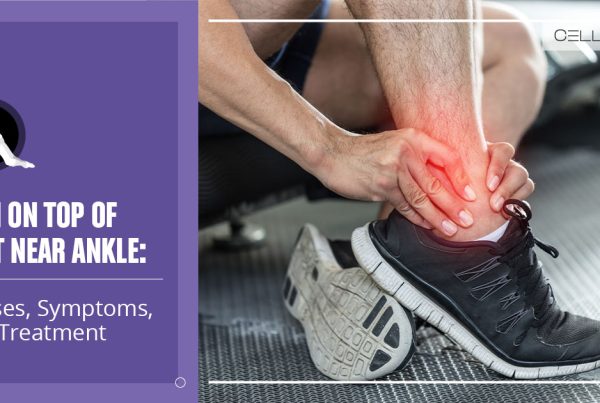Published on: March 29, 2024 | Updated on: January 18, 2025
Heel bone pain can spoil your mood and fun anytime, making you unable to walk, run, or jog. It typically occurs from inflammation, nerve compression, or medical issues like Achilles tendon or plantar fasciitis.
The heel bone pain’s location and intensity varies depending on its cause. While some people experience mild pain on the lateral side, others feel it severely under the heel. Acute cases of heel bone pain usually resolve in a few days with some at-home treatments like resting, orthotics, and stretching.
However, in some cases, the pain can become chronic despite the conventional remedies. In such a situation, the doctor may recommend surgery. If you don’t want to go this route, regenerative medicine can be your lifesaver here.
Heel Pain: A Brief Outlook
Heel pain is a common ankle condition affecting mobility regardless of age and gender. A study found plantar heel pain affecting one in 10 adults above 50. The pain can develop in different parts of the heel, including the outer (lateral) side, beneath the heel, or within the heel bone.
The pain is identified by severe tenderness, inflammation, or soreness in the affected area. When left untreated, it can worsen, making it impossible to stand up or even sit. You may also stay restless throughout the night.
Therefore, you must consult a healthcare provider when you experience heel bone pain. The quicker, the better.
What Does Heel Pain Feel Like?
The symptoms of heel pain vary from person to person, depending on the cause. Most people experience the following symptoms:
- An unusual bony growth around the heel
- Visible redness or bruising
- Stiffness
- Soreness or swelling
- Tenderness
- Intense pain after suddenly standing from a sitting position
Causes of Heel Bone Pain
Heel bone pain can develop due to many underlying health conditions. The most prominent of them include the following:
Achilles Tendinitis
The Achilles tendinitis occurs because of the overuse of the Achilles tendon, a fibrous tissue that attaches calf muscles to the heel bone. In fact, it is the longest tendon in our body. If you practice extensive sports regularly, like running and playing basketball, you are more prone to heel bone pain, stiffness, and swelling caused by Achilles tendinitis.
Plantar Fasciitis
Plantar fasciitis occurs when connective tissue running along the foot’s bottom, called fascia, stretches or tears. This condition primarily affects the heel bone from the bottom area. People who work out extensively, run, or jump on hard surfaces are more likely to develop plantar fasciitis.
If left untreated, plantar fasciitis can lead to heel spur (an unusual bony growth) in the heel bone. These spurs can be painful in some conditions.
Bursitis
Bursitis refers to the swelling in one or more bursae, fluid-filled sacs that cushion the joints and facilitate fluid movement. This condition typically occurs due to prolonged walking and running. Bursitis causes tenderness and soreness in your heel’s back.
Haglund’s Deformity
Haglund’s deformity is an unusual bony growth (pump bump) in the heel’s back caused by chronic irritation and inflammation. Wearing uncomfortable shoes in this condition can worsen your pain and expand the bump.
Calcaneal Apophysitis (Sever’s Disease)
Sever’s disease is a common juvenile health issue, causing intense heel bone in children aged 8 to 14 who actively participate in sports. Spending too much time running and jumping can irritate the heel’s growth plate, increasing the chances of calcaneal apophysitis.
Bone Bruise (Contusion)
Bruising in the heel’s fat pudding can also lead to intense heel bone pain. It occurs when you step on a hard and sharp object. A contusion is identified by discoloration, tenderness, and soreness in the heel.
Bone bruises may also be accompanied by stress fractures and Sever’s disease. In such a situation, you will feel pain along the heel’s back on the side and bottom.
Treatment of Heel Bone Pain

Most patients with heel bone pain find relief with nonsurgical, at-home remedies. These treatments improve inflammation and pain, relieve stress, and enhance your foot’s flexibility.
However, if your heel bone pain persists, regenerative medicine-based methods, cell-based therapies and platelet-rich plasma (PRP) therapy, can be the best alternatives.
Conventional Methods
Some effective at-home methods for heel bone pain include:
- Steroid Injections. These injections can relieve pain and swelling in your heel caused by bursitis or plantar fasciitis. However, they should be given in rare conditions only.
- Physical Therapy. Your doctor may also recommend massage, ultrasound therapy, and physical therapy to treat heel bone pain and inflammation. A professional physical therapist will help you perform stretching exercises as well.
- Medicines. You may need nonsteroidal anti-inflammatory drugs (NSAIDs) with heat or ice therapy. This combination relieves swelling and pain in the heel.
- Orthotic Devices. Orthotics specially designed for heel support are ideal for relieving heel bone pain. These are custom-made shoe inserts designed to take away the stress from your heel. Many people feel an improvement in their pain overnight, while some need a walking boot to relieve the symptoms. It’s also a good practice to wear supportive shoes instead of high heels.
Regenerative Medicine-Based Treatments
For heel bone pain that persists even after the above conventional methods, the doctor suggests cell-based therapies and platelet-rich plasma (PRP) therapy. Both these treatments are based on regenerative medicine, using the patient’s own cells or tissues to treat a health issue.
At CELLAXYS, our board-certified surgeons perform both cell-based and PRP therapies.
Cell-based Therapies
Cell-based or stem cell therapy replaces the patient’s damaged or inflamed cells and tissues with healthy ones. When the doctor extracts healthy cells from the adipose (fat) tissues, the process is called Minimally Manipulated Adipose Tissue Transplant (MMAT). The best part about MMAT is that the doctor can perform it in multiple locations in the same procedure.
However, if the surgeon takes highly concentrated cells from the patient’s bone marrow, the process is called Bone Marrow Concentrate (BMAC). Both cell-based therapies are completed within 1.5 to 2 hours, allowing the patient to go home a few hours after the procedure.
PRP
In PRP, the surgeon takes the patient’s blood sample, separates platelets, and reinserts them into the injured heel area. Platelets perform three primary functions in our body: release 10 growth factors for new tissue development, attract healing cells from the blood, and produce a web-like scaffolding called fibrin.
All these characteristics make platelets efficient healing components of our body. PRP takes about 45 minutes to complete and is considered one of the best treatments for sports, bone, and orthopedic-related injuries.
People who opt for cell-based therapies and PRP for their heel bone pain report instant relief, improved swelling, and better foot flexibility within a few weeks.
Sources
Footnotes
- Agyekum EK, Ma K. Heel pain: A systematic review. Chinese journal of traumatology. 2015;18(03):164-9.
- Thomas MJ, Whittle R, Menz HB, Rathod-Mistry T, Marshall M, Roddy E. Plantar heel pain in middle-aged and older adults: population prevalence, associations with health status and lifestyle factors, and frequency of healthcare use. BMC Musculoskelet Disord. 2019;20(1):337.
- Mazzone MF, McCue T. Common conditions of the Achilles tendon. American family physician. 2002;65(9):1805-11.
- Prichasuk S. The heel pad in plantar heel pain. The Journal of Bone & Joint Surgery British Volume. 1994;76(1):140-2.
- Stephens MM, Sammarco GJ. Heel pain: shoes, exertion, and Haglund’s deformity. The Physician and Sportsmedicine. 1992;20(4):87-95.
- Crawford F, Thomson CE, Cochrane Bone, Joint and Muscle Trauma Group. Interventions for treating plantar heel pain. Cochrane Database of Systematic Reviews. 1996;2009(4).
References
- Heel Pain. Cleveland Clinic. Accessed 10/19/2023.
- What causes heel pain, and what to do about it. Medical News Today. Accessed 10/19/2023.
- Heel pain. Mayo Clinic. Accessed 10/19/2023.
CELLAXYS does not offer Stem Cell Therapy as a cure for any medical condition. No statements or treatments presented by Cellaxys have been evaluated or approved by the Food and Drug Administration (FDA). This site contains no medical advice. All statements and opinions are provided for educational and informational purposes only.
Dr Pejman Bady
Author
Dr. Pejman Bady began his career over 20 years ago in Family/Emergency Medicine, working in fast-paced emergency departments in Nevada and Kansas. He has served the people of Las Vegas as a physician for over two decades. Throughout this time, he has been met with much acclaim and is now the head of Emergency Medical Services in Nye County, Nevada. More about the doctor on this page.
Dr Pouya Mohajer
Contributor
Pouya Mohajer, M.D. is the Director of Spine and Interventional Medicine for CELLAXYS: Age, Regenerative, and Interventional Medicine Centers. He has over 20 years of experience in pain management, perioperative medicine, and anesthesiology. Dr. Mohajer founded and is the Medical Director of Southern Nevada Pain Specialists and PRIMMED Clinics. He has dedicated his career to surgical innovation and scientific advancement. More about the doctor on this page.









